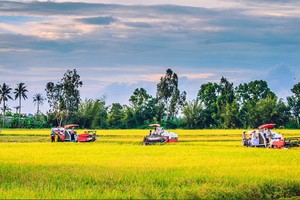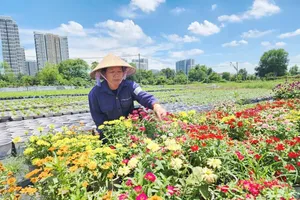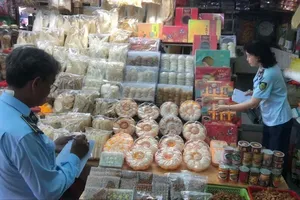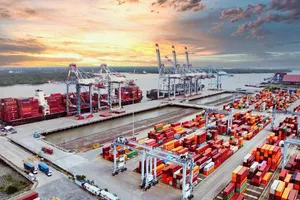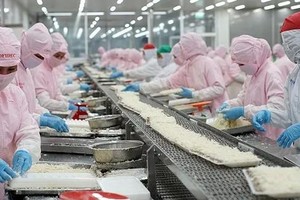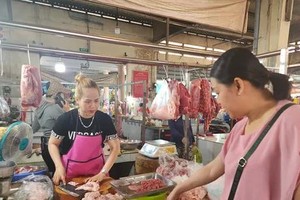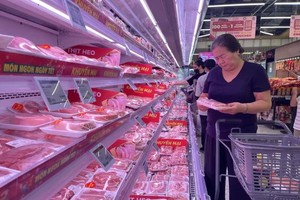
Dong Nai Province is currently the largest banana cultivation area in the country, covering approximately 14,000 hectares. The main variety grown is the tissue-cultured Grand Nain banana, primarily for export.
Before 2016, the cultivation area for Grand Nain banana was only about 100 hectares, but due to rising prices and increased demand for exports to the Chinese market, traders flocked to buy directly from the orchards, leading to a boom in banana cultivation.
Many farmers even uprooted pepper plants to switch to banana cultivation, resulting in an increase of over 600 hectares within just one year, causing supply to exceed demand. The bumper harvest of bananas has crashed its prices.
In 2017, China halted the import of tissue-cultured Grand Nain bananas from Vietnam, leaving banana growers in Dong Nai Province in distress. Overripe bananas couldn’t be sold in time, leading to spoilage. Despite the plummeting prices ranging from VND1,000-VND2,000 per kilogram, traders remained indifferent, and farmers were left with no choice but to let the ripe bananas fall or feed them to cattle and goats.
Administrators of Dong Nai Province had to establish a task force appealing to businesses, organizations, and individuals to help consume the surplus bananas. Through social media, many companies and individuals in Ho Chi Minh City, Binh Duong Province, Ba Ria - Vung Tau Province, and other areas stepped in to support the Dong Nai farmers by purchasing bananas.
However, after the 2018 Lunar New Year, banana prices continued to rise. Traders from northern provinces and China directly committed to purchasing, harvesting, packaging, and transporting bananas from the orchards to China. As a result, banana prices increased from VND10,000 a kg at the beginning of the season to VND14,000-VND15,000 a kg, causing a ‘banana fever’ in the market in Dong Nai Province.
Some individuals profited significantly, such as farmer Nguyen Van Manh in Bau Ham Commune of Thong Nhat District, who earned around VND5 billion in profit from cultivating 10 hectares of bananas after deducting expenses. Consequently, banana cultivation areas expanded rapidly despite the warning of the Department of Agriculture and Rural Development in Dong Nai Province about abundant supply, potentially resulting in another banana glut as seen in previous years. Despite the high banana prices, farmers continue to expand their cultivation areas, and the risk of oversupply remains significant.
Elsewhere in the Mekong Delta region, during the recent saltwater intrusion, more than 1,000 hectares of late winter-spring rice in Soc Trang Province have dried up, and nearly 40,000 hectares of other rice have suffered reduced yields.
Director Huynh Ngoc Nha of the Soc Trang Department of Agriculture and Rural Development pointed out the culprit of severe damage was that farmers did not follow the recommendations of the agricultural sector.
From mid-2023, when experts and meteorological agencies forecast that under the influence of El Nino, the 2023-2024 dry season would be severe and prolonged, the provincial Department of Agriculture coordinated with local authorities to recommend and encourage farmers not to plant the late winter-spring rice crop and to switch to other crops to avoid saltwater intrusion. However, due to traditional production practices and taking advantage of high rice prices, several farmers still planted rice regardless. As a result, most of the late winter-spring rice area was severely damaged," Mr. Nha said.
In Dong Nai province, efforts have been concentrated on planning and guiding farmers toward production linked to consumption contracts. Additionally, farmers register cultivation area codes to participate in the banana export market and boost domestic consumption through retail supermarket systems.
Specifically, farmers in Trang Bom District with the largest area of tissue-cultured Grand Nain bananas in Dong Nai Province have learnt a lesson from past experiences. They signed contracts for banana sales through cooperatives and businesses responsible for distribution and export. Currently, the district has approximately 6,000 hectares of tissue-cultured Grand Nain bananas, nearly equivalent to the entire area in Dong Nai seven years ago. Encouragingly, farmers have adopted more systematic production practices.
Chairman Le Ngoc Tien of the People’s Committee of Trang Bom District remembered that in 2024, neighboring countries like Laos and Cambodia were also expanding their banana cultivation areas.
Even the Central Highlands provinces are increasing banana cultivation. Although exports have slowed down, local farmers have learned from past challenges. Many areas have transitioned to organic production to mitigate harmful diseases such as banana wilt. Some have registered barcodes for legitimate exports to China, preventing a repeat of the surplus situation that required ‘rescue’ efforts.
According to a representative of the Southern Horticulture Research Institute, the vicious cycle of "bumper harvests, low prices" and "cut down - plant - cut down" in the agricultural sector for a long time is the consequence of farmers spontaneously and extremely planting crops without following the planning, recommendations, and guidance of functional agencies. Although many localities have made efforts to advise farmers to carefully consider before deciding what to plant, there is a need for more drastic policies.
With the same opinion, Director of the Department of Agriculture and Rural Development of Tien Giang Province Nguyen Van Man said that in order to prevent unregulated planting and production according to the movement, the province annually issues a conversion plan for each group of crops and the conversion area of each locality based on the orientation of the province's Crop Conversion Project. In addition, the Department of Agriculture and Rural Development of Tien Giang Province also publishes the planning of planting areas and recommends farmers cultivate according to the plan.
The Director of the Department of Agriculture and Rural Development of Tien Giang Province believes that it is necessary to have more drastic and stronger measures, such as having regulatory sanctions. Depending on the type of crop, the consequences left behind, and the impact on the market when farmers produce spontaneously, not according to the plan, there will be appropriate handling methods.
According to statistics, in 2023, the country had 154,180 hectares of banana cultivation. Among these, Dong Nai Province had the largest banana cultivation area, covering over 14,000 hectares, which accounted for 8.5 percent of the national total.
Dong Nai Province was also the leading province in banana cultivation within the Southeast region, representing 70 percent of the entire region’s area. In the same year, Dong Nai exported nearly 121,000 tons of bananas, valued at VND1,149 billion (over US$45,000,000)
Notably, this marked the first year that Dong Nai officially exported fresh bananas to the Chinese market. Currently, the province has 31 designated banana cultivation areas with a total area of 5,600 hectares.

